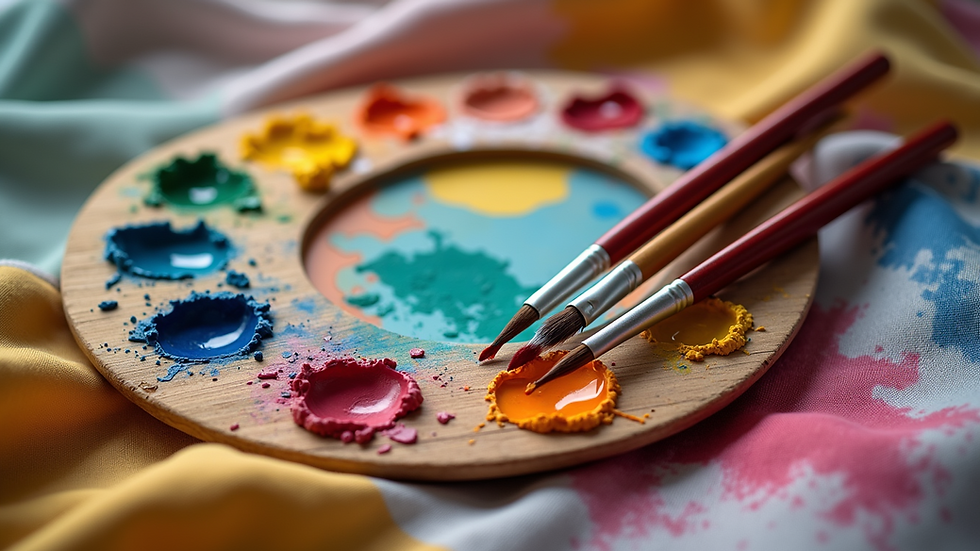How long does fabric paint take to dry? Real timelines, curing, and pro tips 🎨
- Riley Thorne

- 4 days ago
- 3 min read
If you’re customizing shirts, canvas totes, or upholstery, the first question is how long does fabric paint take to dry—and the real key is the difference between dry and cured. Dry is safe to touch; cured is wash- and wear-ready. Below is a fast guide you can follow on any project. ⏱️
Dry ≠ Cured. Dry is touch-safe; cure is when the paint’s film fully sets and bonds to fiber—usually after additional time and/or heat-setting. Always read the product label. Some fabric paints need heat to lock in color; others air-cure only.

How long does fabric paint take to dry — the fast answer
Most acrylic-based fabric paints dry to the touch in a few hours, can be handled carefully later the same day, and reach a full, washable cure after several days (or sooner if heat-set). Thickness, fabric type, humidity, and airflow change everything.
Typical timelines by product type
Fabric paint type | Touch-dry | Handle/light use | Fully cured / wash-safe | Heat-set needed? |
Acrylic fabric paint (brushed, thin coats) | 1–2 hrs | 12–24 hrs | 72 hrs (or per label) | Often recommended |
Dimensional/puff paint (thicker) | 3–4 hrs | 24–48 hrs | 5–7 days | Usually no heat; air-cure |
Spray fabric paint / soft dye sprays | 30–60 min | 12–24 hrs | 72 hrs | Commonly yes |
Screen-print inks (water-based) | 1–2 hrs | 24 hrs | 72 hrs (post-press) | Yes (iron/press) |
Pro tip: Multiple light coats cure faster and flex better than one heavy coat. Heavy layers trap moisture and stay tacky.
What impacts dry time (and how to speed it safely)
Coat thickness: Thin, even coats dry fastest.
Fabric: Natural, open weaves (cotton/linen) absorb and dry faster than tight synthetics.
Temperature & humidity: Aim for ~70–75°F (21–24°C) and 30–50% RH; high humidity can double dry time.
Airflow: A box fan on low, across the surface—not directly at it—prevents skinning.
Cure method: Many paints strengthen with heat.
Simple heat-setting method (check your label first)
Wait until the paint is fully dry to the touch.
Place a pressing cloth or parchment over the design.
Iron on medium (cotton) 3–5 minutes, moving constantly; or tumble-dry low 30 minutes if label allows.
Wash after 72 hours (inside out, gentle, cool water).
Heat-set only after dry. Pressing too soon can smear the film or transfer color to your iron.
Bonus: exterior paint vs fabric paint drying (secondary keywords)
Homeowners also ask how long does it take for exterior paint to dry or how long does it take outdoor paint to dry. Different chemistry, different rules:
Exterior paint | Touch-dry* | Recoat window | Full cure |
Latex/acrylic exterior | ~1 hr @ 70°F, 50% RH | 4 hrs typical | 7–30 days |
Oil/alkyd exterior | 6–8 hrs | 24 hrs | 7–14 days |
*Wind, shade, temperature, and humidity swing these times widely; always follow the can’s instructions.
FAQ
How long does fabric paint take to dry? Most acrylic fabric paints are touch-dry in 1–2 hours, handle in 12–24 hours, and wash-safe after ~72 hours or once heat-set per label.
Can I speed it up safely? Yes—apply thin coats, keep the room ~70–75°F with gentle airflow, and dehumidify; avoid blasting heat directly on wet paint.
Do I always need to heat-set? No—some products air-cure, but many recommend heat for wash durability; check the bottle.
When can I wash the item? After 72 hours (or as directed) and after any required heat-setting; wash inside-out on gentle.
How long does it take for exterior paint to dry? Latex can be touch-dry in about 1 hour and recoat in 4 hours under ideal conditions; oil takes longer—see table above.
Conclusion
So, how long does fabric paint take to dry? Plan for a few hours to touch, a day before handling, and a full cure in about three days—quicker and tougher if you heat-set correctly. Control humidity, use thin coats, and let time (and heat) do the bonding; your designs will flex, wash, and wear like they should.



Comments